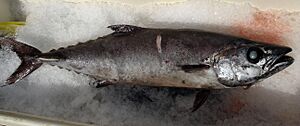Escolar facts for kids
Quick facts for kids Escolar |
|
|---|---|
 |
|
 |
|
| Conservation status | |
| Scientific classification | |
| Genus: |
Lepidocybium
|
| Species: |
flavobrunneum
|
| Synonyms | |
|
|
The escolar, also known as Lepidocybium flavobrunneum, is a type of fish. It belongs to the Gempylidae family. You can find this fish in deep tropical and temperate waters all over the world. It usually lives between 200 and 885 meters (656–2,904 feet) deep.
People sometimes call the escolar by other names. These include snake mackerel or walu walu in Hawaiian. Sometimes, it is even sold as "butterfish" or "white tuna".
Contents
What is Escolar Like?
Appearance and Features
The escolar fish starts out dark brown. As it gets older, its color becomes even darker, turning almost black. It is a very fast swimmer. This fish has a noticeable lateral keel, which is a ridge along its side. It also has four to six small fins, called finlets, behind its main fins.
Size and Diet
Escolar can grow to be very large, over 2 meters (6.5 feet) long! Like its relative, the oilfish (Ruvettus pretiosus), the escolar eats foods that contain special fats called wax esters. However, its body cannot properly break down these wax esters. This means the escolar's meat naturally has a high oil content, usually between 14% and 25%.
Why Escolar Can Cause Health Issues
Understanding Wax Esters
Because escolar cannot break down wax esters, eating it can sometimes cause a condition called keriorrhea. This word comes from Greek and means "flow of wax." It is also known as gempylotoxism or gempylid fish poisoning.
Symptoms and Prevention
If you eat escolar, symptoms can appear from 30 minutes to 36 hours later. These might include stomach cramps or quick, loose bowel movements. This condition is also sometimes called steatorrhea.
There are a couple of ways to lower the chance of getting sick from escolar. One way is to eat only small amounts, about 170 grams (6 ounces) or less. Another tip is to eat parts of the fish closer to the tail. These parts usually have less of the wax esters. Scientists are still debating if things like deep skinning, freezing, or grilling the fish help reduce these effects.
Why Escolar is Sometimes Misidentified
The Problem of Mislabeling Seafood
Escolar can often be mislabeled in restaurants and fish markets. This means it is sold under a different name. For example, in 2009, scientists tested "white tuna" from sushi restaurants in New York City and Denver. They found that five out of nine restaurants were actually serving escolar instead of tuna.
Studies on Mislabeling
Between 2010 and 2013, an ocean protection group called Oceana did a study. They tested over 114 samples of "tuna." Their study showed that 84% of the fish sold as "white tuna" was actually escolar.
Oceana says that escolar has been confused with many other fish. These include Atlantic cod, oilfish, rudderfish, blue cod, black cod, king tuna, grouper, orange roughy, sea bass, gemfish, Chilean sea bass, and albacore tuna. This mislabeling can happen by mistake or on purpose. Oceana believes it is more dangerous than other fish mislabeling. This is because of the possible health effects of eating escolar.
Rules and Bans on Escolar Sales
International Regulations
Some countries have banned the sale of escolar because of its possible side effects. Italy and Japan, for example, do not allow it to be sold. Japan has considered it toxic and banned it since 1977. In 1999, food agencies in Sweden and Denmark warned fish sellers about problems escolar could cause. They also gave advice on how to prepare it safely.
Actions in Asia and the US
In 2007, the Hong Kong government's Centre for Food Safety advised against using escolar in restaurants. They also suggested clear labeling of fish and buying from trusted sources. They wanted people to know about the health effects of escolar and similar fish.
In the United States, the FDA once advised against importing escolar in the early 1990s. This was after people reported getting diarrhea from it. However, the FDA later changed its mind. They decided the fish was not toxic or deadly. Now, the FDA informally suggests that escolar should not be sold across different states.
Canadian and Hawaiian Approaches
In mid-2007, the Canadian Food Inspection Agency looked into cases of diarrhea from mislabeled fish. They decided not to ban escolar. Instead, they shared information about its possible effects. They advised consumers to talk to their fish seller, check the fish species, and eat small portions. They also suggested cooking methods that reduce the oil content.
In Hawaii, State Representative James Tokioka tried to pass a bill in 2010. This bill would have banned catching, selling, or owning escolar. However, the bill did not pass.


